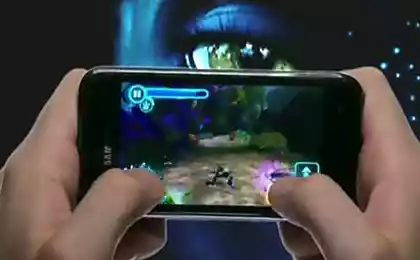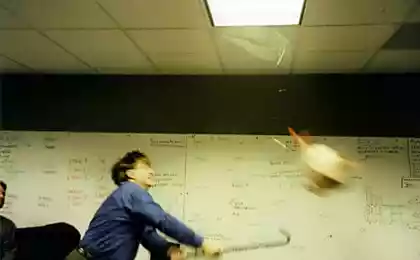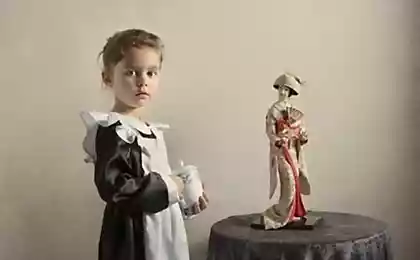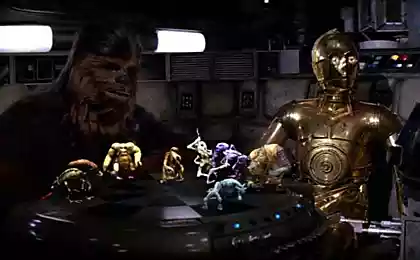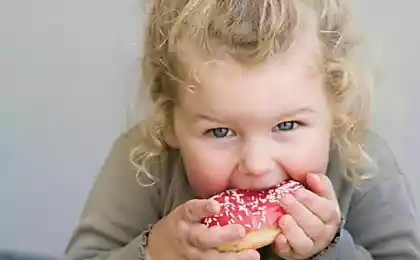573
Games to relieve stress and anxiety in a child
In a child's life occur constantly disturbing and stressful events. Mom went to work, the family moved to another area, born a younger brother or sister, seriously ill grandmother. We are not able to protect children from anything that might cause them trouble, but we can help them survive stressful events and out of collision with them psychologically more stable. If you notice that your child has become more anxious, aggressive, stopped to share with you what scares him, these simple games will help him cope with difficult emotions. Take your time, patience and — play.

1. Plant
We use the metaphor of a plant, and takes root in a new place. Write a story (draw a picture, sculpt from clay - clay, using natural materials and "animating" them with stickers eyes or drawings) on the Seed (Flower or Tree), which is transplanted into another pot (he wind shifts, carrying a family to look after and care for. Or the seed itself has gone to travel.
The tale of how the tree eyeing the new "soil" looks at who is growing nearby, takes root. Root. And over time it begins to bloom, it has come friends – birds, running animals... If a tree, according to the child that feels uncomfortable and unsafe, we ask — what would have helped him, maybe a fence, maybe an angel or fairy trees, maybe an adult friend. (After practice to approach the real tree, tie a ribbon, to hug him, to Pat)
2. Life line
Children undergoing stress are capsuled in past traumatic events. They seem to be separated from reality. Return them to the "real" game — "lifeline". This practice can be done only when an adult is sufficient time and resource. Thread or ribbon, lay out a long straight line. (It is ideal to use garland with glowing lights). Depending on how many the child years put on the line bright objects (shoes) — a few steps from each other. The number of marks for number of years + 1 (one year from the actual age) and +1 after 5 years from the real age.
Line of thread should be much longer than the marker of age. The child becomes the first "notch" — we remind him that this point where he is only a year old. At this point the baby is just starting to go (baby can sit, ask to handle, be sure to hug him if he asked. You can even give a drink of water from the tube). As you move along the line, the child straightens.
At each stop — we speak sincere words. "Oh! Another year! As I'm glad. This year you've become/I'm talking some kind of achievement)".
Definitely a little longer to stand up to the mark real age... And then the child takes a step into the "future" — a parent says — "Oh! You'll be such a happy adult!". Perhaps to pick up the child in his arms and "fly" over the thread....
For reading, the children can spread out at years papers with written wishes or resource words. More simple variant — chalk "classics". A child jumps in the box age. In this cell waiting for his inverted sheet with a picture, words, heart, surprise, you want to open. The last cell drawn joyful characters. (In secret: it is a wonderful game for Birthday).
3. Game face
On the face of person of any age who have suffered trauma can freeze mask. (Permanent passive, or trapped in one difficult - definable emotion expression). In this case, it would be useful for any "plastic" of the game.
You can start with kneading this piece of clay. Then "turn" the baby into the clay. From his face "vyleplivat" of different shapes (cherubim cheeks, we ask you to inflate the cheek...)
Play competition "Krivolak". Writhing with the child all kinds of faces.
Mask. Use ready-made, cut, coloring. The child chooses a mask of his "power walks, talks, gestures of this role. Then wears a mask "weakness" (e.g., fear). Speaks on behalf of this mask. Then removes the mask. At the end we ask, but when would you need the first mask? how it can help the second mask?
Become actors and do a small performance of any tale. The simplest turnip, gloves...
4. Simple holidays
The man who has had a difficult experience you often have a feeling of the impossibility of joy in the future and "betrayal" in front of a heavy event or other affected people, a great wine and the resistance, if you allow yourself even a little fun.
It is important to help babies again to afford joy. Guilt of the past or those people who harder. Do surprises loved ones. Focus on accomplishments (write, draw, note what was good for the day.
Invent holidays.
For example, a holiday zasilania bed. Holiday fluffing pillows, holiday soap foam on his cheeks, a holiday cleanser a toothbrush. specifically focus on "physicality". Often, traumatized children begin to carefully wash or avoid the topic of washing, purity, touching the body.
5. Color therapy
The child is often "hangs" in the past, ceasing to pay attention to the current day. Experience heavy transports of the past into reality. His gaze as if turned inward. Show the child a "time" and fixate on each day, enlivens the senses. For example, each day is given a specific color. Suppose a medium — red. Throughout the day, looking for red items, eat red foods themselves use the red color in clothes, accessories.
6. Where are you?
For fixing on the present we often play a game of "where are you?". Ask unexpectedly, at any time of the day the question — "where are you?". The answer must begin with the words "I'm here!". Then a few sentences about it "here", with a description of different modalities — aroma, sound, physicality, taste. For example: I'm here. In the room, sitting on a soft cushion with a computer on his lap, eating a sweet berry.
7. Make a schedule
For the stabilization, support to return and relieve anxiety the child may need more information and external predictability. That is quite a clear agenda. And any structure. What you can plan — plan. Be sure to warn about the change in plans. You can make a schedule together, decorate it to instruct the child to monitor the implementation of the plan is good.
8. Garland
Many kids need more contact, but avoid contact. This little practice is a good for shy children and for the adaptation to a new group.
Cut paper garland-little men holding hands. You can draw faces, you can write the names of friends, relatives, children from the group. So we create the metaphor of being — "we are together"
9. A drop of paint
For stress relief, relaxation, transformation, fixation on a single experience, condition, event. Drip watercolor paint into the water, the patterns on the water, watching as it dissolves the paint. It would be great if then the child to dance, to live plasticity of the body movement of ink in water. Let the baby her body will show the movement of the waves of watercolors.
10. Prints
Another very simple environmentally friendly -"the quickening" technique, helps to remove the ban on imagination and feeling.
Traumatized people freeze sensitivity — if I allow myself to feel, along with joy will manifest fear, pain and anger. And also create the metaphor of the "multi-variant". (This technique helps with neurotic constipation).
Dip thumb in paint or beet juice. Put on the sheet a few finger prints. Ask what you need to finish to get a pig, hare, Swan, fish...
11. Draw on dark or black paper
Crayons, pastels, gouache. Any topic. This method helps in transforming alarm outputs "on the surface" zacapawanyi fear. From the darkness of the unknown, past, terrible, acts something new and colorful.
Metaphor: out of the darkness of the night is born new life.
12. Let go into the sky
Past experience is difficult to let go. People who have experienced trauma or loss may begin to "cling" to what he thinks is important and expensive. We need the metaphor of a "release happy" — balls. Let go into the sky balls, let boats on the river...
13. Return identification
Work with the name. Write in a column the letters of the name. For each letter name recall some of the resource quality.
For example: VANYA — Attentive, Careful, Gentle, Bright
14. Turn into super-heroes
Often a child who survived a difficult experience coping with increased care and attention that adults do a lot for him. Such a child becomes more childish, passive. It is important not to provoke the child "learned helplessness".
They made every action has a resource for its future. Not doing for the child what he can do! When a child says "I can't! it will not work! help!", when whines and shies away from action — playing the game Turn into supermen.
"Now I'm you and you me turn into Superman. You only need to eat (candy, berry, vitamins, drink juice, mors....).
"You have some superpowers? I have to carry things. Look, I carry the Laundry basket in the bathroom. And you — come speed. And you will quickly be able to go? (To get out of bed, dress, eat...)"
15. Play baby
Often the subconscious mind of the children transports them into the age when they were happy and lived in a sense of security. They behave like kids, Lisp, ask for pens. We play with the child in the "kid", give energy forces its child parts. And then "turn" him into an adult.
Give the child the opportunity to command — how many steps to go (the game is "huge midgets"), be his "sous chef" in the kitchen, give him the opportunity to choose the walking route (you can even give the wheel cover from the pan in hand)
16. Natural stage
Aggression — looking for environmentally friendly ways to stay snapping bubble packaging, a pillow fight, to knock down bowling pins to hammer "nails".
Fear of loud noises — playing with applause and musical instruments.
Fear of touch — imagine that it's raining. first he knocks on the palms of the child (the pads of your fingers knock on the palms, then over the body. The rain can be of different strength.
17. Jumping
Anxious kids intuitively choose for themselves jumping games. They need to jump on the trampoline (the trampoline is they will still choose a bed :-). Jumping relieves stress, give the opportunity to feel the support on the foot, "weightlessness" when jumping affects the stem structures of the brain. Instead of prohibiting jump, you can create "special places for jumping". For example — "here you can jump on one foot, then two.."...
You need to consider that the child will ask to play or to read what it is important and healthful, a few times. Adult patiently and happily plays and reads. The child will not play the game that is causing his emotions, which he is not ready to handle. Treat it with respect and do not insist.published
Author: Svetlana Roiz
P. S. And remember, just changing your mind — together we change the world! ©
Source: alpha-parenting.ru

1. Plant
We use the metaphor of a plant, and takes root in a new place. Write a story (draw a picture, sculpt from clay - clay, using natural materials and "animating" them with stickers eyes or drawings) on the Seed (Flower or Tree), which is transplanted into another pot (he wind shifts, carrying a family to look after and care for. Or the seed itself has gone to travel.
The tale of how the tree eyeing the new "soil" looks at who is growing nearby, takes root. Root. And over time it begins to bloom, it has come friends – birds, running animals... If a tree, according to the child that feels uncomfortable and unsafe, we ask — what would have helped him, maybe a fence, maybe an angel or fairy trees, maybe an adult friend. (After practice to approach the real tree, tie a ribbon, to hug him, to Pat)
2. Life line
Children undergoing stress are capsuled in past traumatic events. They seem to be separated from reality. Return them to the "real" game — "lifeline". This practice can be done only when an adult is sufficient time and resource. Thread or ribbon, lay out a long straight line. (It is ideal to use garland with glowing lights). Depending on how many the child years put on the line bright objects (shoes) — a few steps from each other. The number of marks for number of years + 1 (one year from the actual age) and +1 after 5 years from the real age.
Line of thread should be much longer than the marker of age. The child becomes the first "notch" — we remind him that this point where he is only a year old. At this point the baby is just starting to go (baby can sit, ask to handle, be sure to hug him if he asked. You can even give a drink of water from the tube). As you move along the line, the child straightens.
At each stop — we speak sincere words. "Oh! Another year! As I'm glad. This year you've become/I'm talking some kind of achievement)".
Definitely a little longer to stand up to the mark real age... And then the child takes a step into the "future" — a parent says — "Oh! You'll be such a happy adult!". Perhaps to pick up the child in his arms and "fly" over the thread....
For reading, the children can spread out at years papers with written wishes or resource words. More simple variant — chalk "classics". A child jumps in the box age. In this cell waiting for his inverted sheet with a picture, words, heart, surprise, you want to open. The last cell drawn joyful characters. (In secret: it is a wonderful game for Birthday).
3. Game face
On the face of person of any age who have suffered trauma can freeze mask. (Permanent passive, or trapped in one difficult - definable emotion expression). In this case, it would be useful for any "plastic" of the game.
You can start with kneading this piece of clay. Then "turn" the baby into the clay. From his face "vyleplivat" of different shapes (cherubim cheeks, we ask you to inflate the cheek...)
Play competition "Krivolak". Writhing with the child all kinds of faces.
Mask. Use ready-made, cut, coloring. The child chooses a mask of his "power walks, talks, gestures of this role. Then wears a mask "weakness" (e.g., fear). Speaks on behalf of this mask. Then removes the mask. At the end we ask, but when would you need the first mask? how it can help the second mask?
Become actors and do a small performance of any tale. The simplest turnip, gloves...
4. Simple holidays
The man who has had a difficult experience you often have a feeling of the impossibility of joy in the future and "betrayal" in front of a heavy event or other affected people, a great wine and the resistance, if you allow yourself even a little fun.
It is important to help babies again to afford joy. Guilt of the past or those people who harder. Do surprises loved ones. Focus on accomplishments (write, draw, note what was good for the day.
Invent holidays.
For example, a holiday zasilania bed. Holiday fluffing pillows, holiday soap foam on his cheeks, a holiday cleanser a toothbrush. specifically focus on "physicality". Often, traumatized children begin to carefully wash or avoid the topic of washing, purity, touching the body.
5. Color therapy
The child is often "hangs" in the past, ceasing to pay attention to the current day. Experience heavy transports of the past into reality. His gaze as if turned inward. Show the child a "time" and fixate on each day, enlivens the senses. For example, each day is given a specific color. Suppose a medium — red. Throughout the day, looking for red items, eat red foods themselves use the red color in clothes, accessories.
6. Where are you?
For fixing on the present we often play a game of "where are you?". Ask unexpectedly, at any time of the day the question — "where are you?". The answer must begin with the words "I'm here!". Then a few sentences about it "here", with a description of different modalities — aroma, sound, physicality, taste. For example: I'm here. In the room, sitting on a soft cushion with a computer on his lap, eating a sweet berry.
7. Make a schedule
For the stabilization, support to return and relieve anxiety the child may need more information and external predictability. That is quite a clear agenda. And any structure. What you can plan — plan. Be sure to warn about the change in plans. You can make a schedule together, decorate it to instruct the child to monitor the implementation of the plan is good.
8. Garland
Many kids need more contact, but avoid contact. This little practice is a good for shy children and for the adaptation to a new group.
Cut paper garland-little men holding hands. You can draw faces, you can write the names of friends, relatives, children from the group. So we create the metaphor of being — "we are together"
9. A drop of paint
For stress relief, relaxation, transformation, fixation on a single experience, condition, event. Drip watercolor paint into the water, the patterns on the water, watching as it dissolves the paint. It would be great if then the child to dance, to live plasticity of the body movement of ink in water. Let the baby her body will show the movement of the waves of watercolors.
10. Prints
Another very simple environmentally friendly -"the quickening" technique, helps to remove the ban on imagination and feeling.
Traumatized people freeze sensitivity — if I allow myself to feel, along with joy will manifest fear, pain and anger. And also create the metaphor of the "multi-variant". (This technique helps with neurotic constipation).
Dip thumb in paint or beet juice. Put on the sheet a few finger prints. Ask what you need to finish to get a pig, hare, Swan, fish...
11. Draw on dark or black paper
Crayons, pastels, gouache. Any topic. This method helps in transforming alarm outputs "on the surface" zacapawanyi fear. From the darkness of the unknown, past, terrible, acts something new and colorful.
Metaphor: out of the darkness of the night is born new life.
12. Let go into the sky
Past experience is difficult to let go. People who have experienced trauma or loss may begin to "cling" to what he thinks is important and expensive. We need the metaphor of a "release happy" — balls. Let go into the sky balls, let boats on the river...
13. Return identification
Work with the name. Write in a column the letters of the name. For each letter name recall some of the resource quality.
For example: VANYA — Attentive, Careful, Gentle, Bright
14. Turn into super-heroes
Often a child who survived a difficult experience coping with increased care and attention that adults do a lot for him. Such a child becomes more childish, passive. It is important not to provoke the child "learned helplessness".
They made every action has a resource for its future. Not doing for the child what he can do! When a child says "I can't! it will not work! help!", when whines and shies away from action — playing the game Turn into supermen.
"Now I'm you and you me turn into Superman. You only need to eat (candy, berry, vitamins, drink juice, mors....).
"You have some superpowers? I have to carry things. Look, I carry the Laundry basket in the bathroom. And you — come speed. And you will quickly be able to go? (To get out of bed, dress, eat...)"
15. Play baby
Often the subconscious mind of the children transports them into the age when they were happy and lived in a sense of security. They behave like kids, Lisp, ask for pens. We play with the child in the "kid", give energy forces its child parts. And then "turn" him into an adult.
Give the child the opportunity to command — how many steps to go (the game is "huge midgets"), be his "sous chef" in the kitchen, give him the opportunity to choose the walking route (you can even give the wheel cover from the pan in hand)
16. Natural stage
Aggression — looking for environmentally friendly ways to stay snapping bubble packaging, a pillow fight, to knock down bowling pins to hammer "nails".
Fear of loud noises — playing with applause and musical instruments.
Fear of touch — imagine that it's raining. first he knocks on the palms of the child (the pads of your fingers knock on the palms, then over the body. The rain can be of different strength.
17. Jumping
Anxious kids intuitively choose for themselves jumping games. They need to jump on the trampoline (the trampoline is they will still choose a bed :-). Jumping relieves stress, give the opportunity to feel the support on the foot, "weightlessness" when jumping affects the stem structures of the brain. Instead of prohibiting jump, you can create "special places for jumping". For example — "here you can jump on one foot, then two.."...
You need to consider that the child will ask to play or to read what it is important and healthful, a few times. Adult patiently and happily plays and reads. The child will not play the game that is causing his emotions, which he is not ready to handle. Treat it with respect and do not insist.published
Author: Svetlana Roiz
P. S. And remember, just changing your mind — together we change the world! ©
Source: alpha-parenting.ru
Socionics: a beautiful theory or science of the future
Russian bath — the forgotten tool in the fight against diseases




